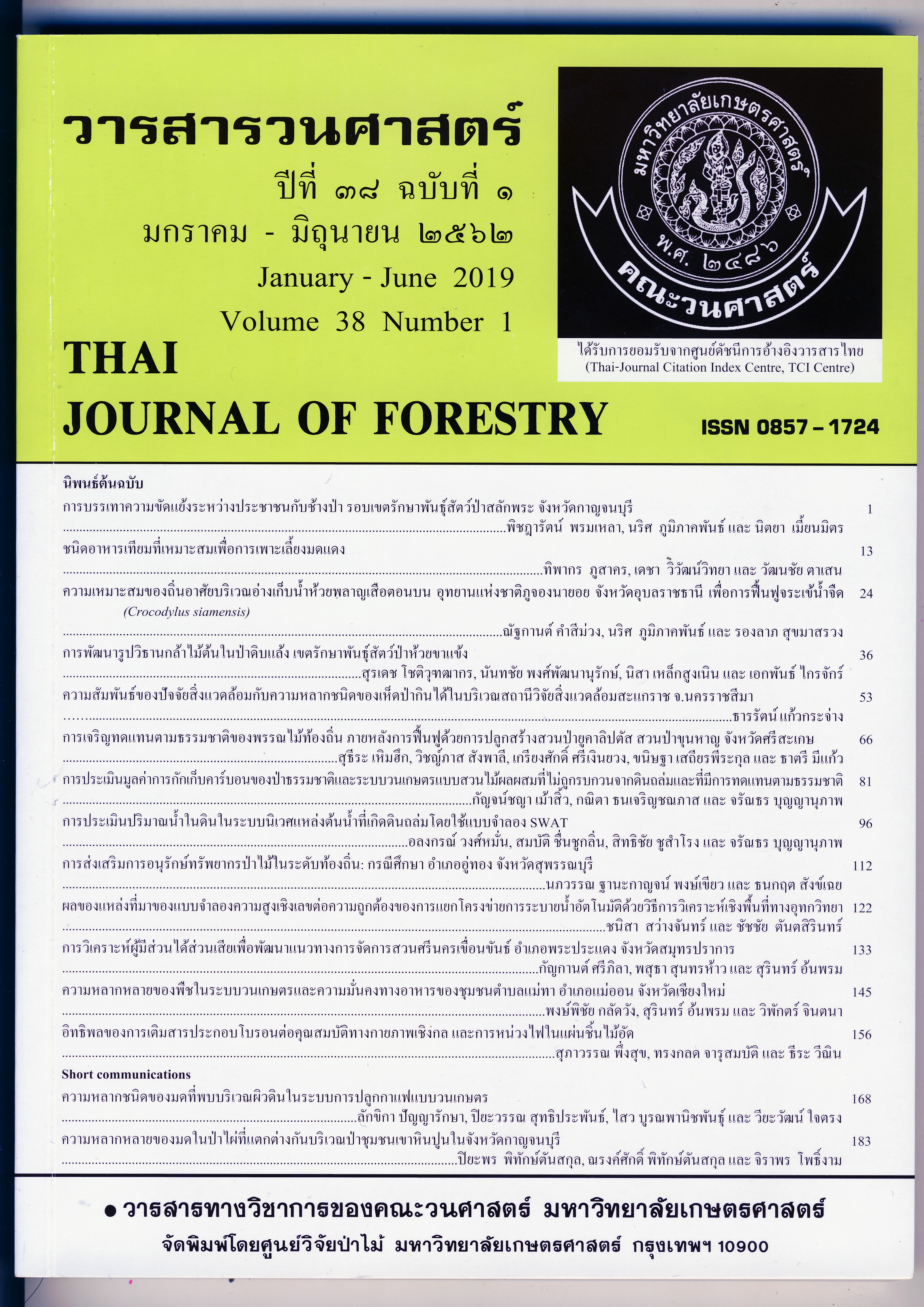ความหลากหลายของพืชในระบบวนเกษตรและความมั่นคงทางอาหาร ของชุมชนตำบลแม่ทา อำเภอแม่ออน จังหวัดเชียงใหม่
Main Article Content
บทคัดย่อ
ระบบวนเกษตรเป็นรูปแบบการใช้ประโยชน์ที่ดินที่ผสมผสานองค์ประกอบระหว่างไม้ยืนต้นกับพืชเกษตรและหรือปศุสัตว์ซึ่งเป็นระบบที่ช่วยอนุรักษ์ ฟื้นฟูทรัพยากรป่าไม้ และช่วยเพิ่มพูนความหลากหลายทางชีวภาพ และคงความสมดุลของธรรมชาติและสภาพแวดล้อม งานวิจัยนี้มีวัตถุประสงค์เพื่อศึกษาความหลากหลายของชนิดพันธุ์พืชและวิเคราะห์ศักยภาพของวนเกษตรต่อความมั่นคงทางอาหารของครัวเรือน โดยเลือกศึกษาระบบวนเกษตรในพื้นที่โครงการจัดที่ดินทำกินให้กับชุมชน จังหวัดเชียงใหม่ จำนวน 59 ครัวเรือน ด้วยการสัมภาษณ์รายครัวเรือนร่วมกับการสำรวจความหลากหลายของชนิดพันธุ์พืชในแปลงวนเกษตร
จากการศึกษา พบชนิดพันธุ์พืชในระบบวนเกษตร ทั้งสิ้น 243 ชนิด ประกอบด้วย พืชอายุยืนยาวที่ให้เนื้อไม้ 144 ชนิด และพืชเกษตร จำนวน 99 ชนิด สำหรับพืชอายุยืนยาวที่ให้เนื้อไม้ จำแนกเป็น ไม้ป่า 77 ชนิด ไม้ผล 26 ชนิด ไม้พุ่ม 27 ชนิด ปาล์มและหวาย 7 ชนิด ไผ่ 7 ชนิด ดัชนีความหลากหลายของพืชอายุยืนยาว เท่ากับ 2.99 ระบบวนเกษตรมีศักยภาพต่อความมั่นคงทางอาหารของครัวเรือนใน 4 ด้าน ได้แก่ การเป็นแหล่งพืชอาหาร แหล่งไม้เชื้อเพลิง สร้างสิ่งแวดล้อมที่เอื้อต่อการเพาะปลูก และสร้างรายได้ให้กับครัวเรือน พบว่า มีชนิดพืชที่สามารถเป็นอาหารของครัวเรือนทั้งสิ้น 163 ชนิด ไม้เชื้อเพลิง 87 ชนิด พืชที่สามารถตรึงไนโตรเจน 9 ชนิด และเกษตรกรที่ทำวนเกษตรมีรายได้เฉลี่ย เท่ากับ 112,942 บาทต่อครัวเรือนต่อปี
Downloads
Article Details
ข้าพเจ้าและผู้เขียนร่วม (ถ้ามี) ขอรับรองว่า ต้นฉบับที่เสนอมานี้ยังไม่เคยได้รับการตีพิมพ์และไม่ได้อยู่ในระหว่างกระบวนการพิจารณาตีพิมพ์ลงในวารสารหรือสิ่งตีพิมพ์อื่นใด ข้าพเจ้าและผู้เขียนร่วม (ถ้ามี) ยอมรับหลักเกณฑ์และเงื่อนไขการพิจารณาต้นฉบับ ทั้งยินยอมให้กองบรรณาธิการมีสิทธิ์พิจารณาและตรวจแก้ต้นฉบับได้ตามที่เห็นสมควร พร้อมนี้ขอมอบลิขสิทธิ์ผลงานที่ได้รับการตีพิมพ์ให้แก่วารสารวนศาสตร์ คณะวนศาสตร์ มหาวิทยาลัยเกษตรศาสตร์ กรณีมีการฟ้องร้องเรื่องการละเมิดลิขสิทธิ์เกี่ยวกับภาพ กราฟ ข้อความส่วนใดส่วนหนึ่ง หรือ ข้อคิดเห็นที่ปรากฏในผลงาน ให้เป็นความรับผิดชอบของข้าพเจ้าและผู้เขียนร่วม (ถ้ามี) แต่เพียงฝ่ายเดียว และหากข้าพเจ้าและผู้เขียนร่วม (ถ้ามี) ประสงค์ถอนบทความในระหว่างกระบวนการพิจารณาของทางวารสาร ข้าพเจ้าและผู้เขียนร่วม (ถ้ามี) ยินดีรับผิดชอบค่าใช้จ่ายทั้งหมดที่เกิดขึ้นในกระบวนการพิจารณาบทความนั้น”
เอกสารอ้างอิง
Food and Agriculture Organization of the United Nations. 2006. World Food and Agriculture in Review. The State of Food and Agriculture.
Jamroenprucksa, M. and S. Khlangsap, 1998. Important Crops in Agroforestry Systems. 1st edition. Bangkok.
Jintana, V. 2007. Agroforestry and Management System. Department of Forest Management, Faculty of Forestry, Kasetsart University.Bangkok.
Lakawiwattanakun, T. 1996. Agro-forestry promotion series.
Muangsan, P. M. Jamroenprucksa, R. Pothitan, and K. Meekaew, 2017. Comparative ecological characteristics and return in smallholding rubber-based monoculture and agroforestry in Nam Noi sub-district, Hat Yai district, Songkhla province. Thai Journal of Forestry 36 (1): 68-78.
National Land Policy Committee. 2016. Guide to organizing arable land for the community according to government policy. 1st edition. Office of Natural Resources and Environmental Policy and Planning, Bangkok.
Onprom, S. and K. Permpoon, 2017. Selection of appropriate trees for agroforestry system by applying analytical hierarchy process (AHP) technique. Thai Journal of Forestry 36(1): 79-88.
Preechapany, P. C. Choocharoen, M. Phokaiphiphat, I. Singkham, P. Uthumpun, W. Chirasukthaweekul, 2003. Local Ecological Knowledge on Highland Agroforestry Systems and Watershed Management, Royal Project FoundationResearch Report. 149 pages.
Samphanpanich, P. 1994. Structural characteristic,litterfall production and decomposition Rate in Home Garden Agroforestry System in Amphoe Muang, Changwat Nonthaburi. M.S. Thesis, Kasetsart University.
Thailand Environment Institute. 2011. Integrated biodiversity value project towards the management of natural resources in Thailand. Bangkok.
Washington, H. G. 1984. Diversity, biotic and similarity indices: a review with special relevance to aquatic ecosystems. Water Research 18: 653-694.


